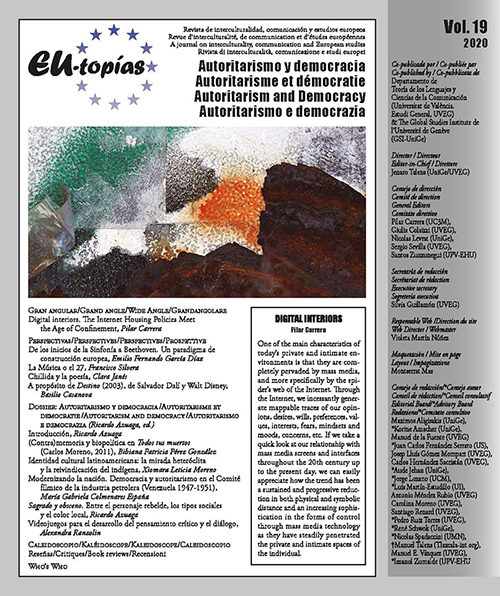From the beginnings of Symphony to Beethoven: a paradigm of European construction
DOI:
https://doi.org/10.7203/eutopias.19.17871Keywords:
National tradition, European style, Synthesis, Symphonic instrumental language, Haydn, Mozart, Schiller, Beethoven, Goya Abstract
Abstract
During the first half of the 18th century the European music scene is characterized by different instrumental styles with a clear national shape, result of the turbulent previous century, that will converge in the creation of the instrumental language that allowed the most important music form in the orchestral genre: Symphony. The masterpieces that stablished the basics of the symphonic genre since then, Haydn and Mozart essentially, will not be the same without the synthesis of styles along the century. Non-musical elements (philosophical, politics, socials, etc.) affected directly in the search of a European style that combined harmonically the best of each national tradition in order to build a language that meant one of the most important productions in our musical history. Once reached the process and known the dramatic consequences of this rational dream that tried to enlighten the European society, so well-illustrated by Goya, Beethoven was able to overcome the emptiness after the big disappointment of these highest ideals to blend in his last Symphony all the original elements of the 18th century tradition and create a universe of sound that retakes some of the most beautiful model of our cultural development. Beyond the Schiller poem, this article tries to underline the compositive elements integrated in the Beethoven most famous Symphony as an inspiring example to get over nationalism and conflicts that reappear today in our common European context.
 Downloads
Downloads
 References
References
Anderson, Emily. The Letters of Mozart and His Family. Nueva York: Norton, 1985.
Geminiani, Francesco. The art of playing on the violin, 1751. Londres: Oxford University Press, 1952.
Grout, Donald Jay y Palisca, Claude. A History of Western Music. New York: Norton, 1996.
Griesinger, Georg August. Apuntes biográficos sobre Joseph Haydn. Madrid: Turner, 2012.
Massin, Jean y Brigitte. Wolfgang Amadeus Mozart. Madrid: Turner, 1987a.
Massin, Jean y Brigitte. Ludwig van Beethoven. Madrid: Turner, 1987b.
Mozart, Leopold. A Treatise on the Fundamental Principles of Violin Playing, trans. Editha Knocker (1948). Londres y Nueva York: Oxford University Press, 1756.
Rice, John A. La música en el siglo XVIII. Madrid: Akal, 2019.
Downloads
Published
How to Cite
-
Abstract552
-
PDF (Español)303
Issue
Section
License
![]()
The authors conserve the copyright. All content published in EU-topías. Journal of interculturality, Communication, and European Studies are subject to the license Creative Commons Attribution-NonCommercial-ShareAlike 4.0 license. The full text of the license can be found at <http://creativecommons.org/licenses/by-nc-sa/4.0>
They may be copied, used, disseminated, transmitted and publicly displayed, provided that:
- The authorship and original source of the publication is cited (journal, publisher and URL of the work).
- They are not used for commercial purposes.
- The existence and specifications of this license of use are mentioned.
It is the responsibility of the authors to obtain the necessary permissions for images that are subject to copyright.



